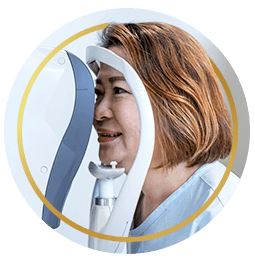Delivering Excellent Eye Care
At Lifetime Optometric, we pride ourselves on delivering excellent eye care by using advanced technology for accurate diagnoses, tailored treatments, and effective monitoring.
Whether you’re seeking eye care for yourself or your child, no matter where you’re at with your eye health, we’re here to help.
If you’re ready to give your eyes the care and attention they deserve, book an appointment with us today! We look forward to meeting you.
Book Appointment
Our Approach
Our Mission
Together, we help transform lives with innovative technology and exceptional care.
Our Vision
We strive to provide exceptional care to every patient every time.
Our Core Values: LTO
- Loyalty for a lifetime
- Teamwork makes the dream work
- Opportunity to make a positive difference
iWELLNESS
Among the top 3 leading causes of blindness are glaucoma, macular degeneration, and diabetic retinopathy—all of which can show little to no signs of symptoms. However, iWellness exams can help us detect changes sooner, helping to prevent damage.
For a nominal fee, you can elect to have the iWellness exam and their comprehensive eye exam.
Patient Referrals
At Lifetime Optometric, we gladly accept referrals from fellow practitioners. Our dedicated team is focused on diagnosing and addressing eye health issues for everyone.
Feel free to fax the referral to 559-432-2203, or you may contact our welcoming staff to learn how we can help you today!
Payment Information
At Lifetime Optometric, we always look for new ways to help our patients. We offer 2 flexible payment options, Cherry and Care Credit, so you can get services now and pay later.
You also have the right to receive a Good Faith Estimate explaining how much your medical care may cost. Please call our office at 559-432-2200 to inquire about pricing.
Cherry Payment Plans
Cherry payment plans offer more convenient ways to help pay for your optometric services. Ask us for our Cherry application link, and once you’re approved, you can receive a personalized payment schedule that suits your needs and budget.
Care Credit
CareCredit is a credit card designed exclusively for healthcare services, with special financing options for 6 or 12 months. Once you’ve approved, you can use it repeatedly at any location that accepts CareCredit. Whether you need a routine checkup or new glasses, you shouldn’t feel limited in your options.
Insurance Information
We accept most major insurance plans for medical eye claims except for HMOs. We also accept VSP and certain EyeMed plans.
Feel free to call our office to see if we work with your insurance carrier or vision care plan. Our friendly and informed staff will happily answer any questions you may have.
Subscribe to Our Membership Plans
No vision plan? No problem!
Lifetime Optometric offers membership plans with no annual limits, no wait times, no age restrictions, and no complicated claims.
Membership plans cover essential services such as annual comprehensive eye exams, and can offer discounts on prescription and non-prescription eyewear and contacts. Simple, affordable, and often cheaper than traditional vision insurance.
Ready to take a proactive step towards your vision health? Signing up is easy:
- Enroll online or in person
- Book your appointment
- Enjoy your benefits!
Ready to make the smart move? Enroll today!
Promotions
We offer a variety of discounts and warranties to our patients based on their purchases with us. Some of our current programs include:
- 20% off non-prescription sunglasses for contact lens patients who order a year’s worth of supply from our office.
- When purchasing an annual supply of contact lenses, enjoy free shipping to your home or work and 50% off a special collection of non-prescription Polarized Sunglasses (only a good 30 days from purchase).
- 60-day prescription check: We offer one recheck of your glasses prescription within 60 days of the original prescription date.
- 1-year manufacturer warranty on frames with a $30 processing fee for each transaction.
- 1-year warranty for anti-reflective coatings and a $30 processing fee for each transaction.
Shop Online
At Lifetime Optometric, we believe in equipping our patients with all the tools and resources they need to maintain optimal eye health. This is why our online store offers eye care products, contacts, frames, and vitamins. Enjoy the convenience and peace of mind of buying quality products from an established practice.
Cancellation & No-Show Policy
At Lifetime Optometric, we are dedicated to providing exceptional care to our patients. When you schedule an appointment, we reserve a specific time for you with the doctor so that they are available to meet your vision and medical needs.
If you need to cancel or reschedule your appointment, please get in touch with our office at 559-432-2200 at least 24 hours in advance. You can text or leave a voicemail, and we accept messages 24/7. This helps us accommodate other patients who may be waiting for an appointment. We will respond to texts and voicemails during business hours.
Please note that missed appointments or cancellations with less than 24 hours notice will incur a fee of $50. This fee is charged to the patient, not the insurance company and any outstanding balances must be settled before future appointments can be scheduled.
If you arrive more than 10 minutes late for your appointment, you may need to reschedule so that patients who arrive on time are seen promptly. Thank you for your understanding!
Our Commitment to Sustainability
At Lifetime Optometric, we’re passionate about protecting our planet. As the demand for eco-friendly products rises, our dedication to sustainability remains at the forefront of our mission. Did you know that 94% of contact lens wearers in the U.S. prioritize keeping plastic out of our oceans? We do, too!
That’s why we collaborate with brands like CooperVision to offer net plastic neutral contact lenses and partner with Bausch & Lomb and Terracycle to recycle contact lens packaging in our offices every quarter. Through this initiative, offices across the country have successfully recycled over 41 million units of contact lenses and lens care materials—keeping nearly 27 million of those out of landfills!
We’re also proud to feature Vision Source Smart Eco frames—ECO (Earth Conscious Optics)—which are crafted from environmentally responsible materials. Our ECO Biobased frames contain 63% biobased materials, while ECO Recycled frames boast an impressive 95% recycled content. When you wear these frames, you’re contributing to a cleaner planet.
ECO’s commitment to sustainability extends to its “One Frame, One Tree” initiative in partnership with Trees for the Future. For every ECO frame sold, a tree is planted—resulting in over one million trees planted to date!
For us, sustainability is our responsibility to the Earth and future generations. Join us in making a difference!
Our Location
We’re located inside The Atrium office plaza on E Herndon Ave, with building and parking access from E Warner Ave.

Our Address
- 1111 E. Herndon Avenue, Suite 101
- Fresno, CA 93720
Contact Information
- Phone: 559-432-2200
- Fax: 559-432-2203
- Email: [email protected]
Our Hours
- Monday*: 8:15 AM – 5:00 PM
- Tuesday*: 8:15 AM – 5:00 PM
- Wednesday*: 9:30 AM – 5:00 PM
- Thursday*: 8:15 AM – 5:00 PM
- Friday: 8:15 AM – 12:00 PM
- Saturday: Closed
- Sunday: Closed
-
*Closed for lunch 12:00 PM – 1:00 PM Monday to Thursday.

Our Brands















